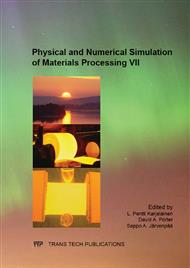p.349
p.354
p.360
p.368
p.374
p.382
p.387
p.392
p.398
Effect of Constrained Conditions on the Equivalent Strain and Microstructure of 5052 Al Alloy Deformed by Groove Pressing
Abstract:
Three-dimensional finite element simulation (3D FES) and experiments were carried out for analyzing the deformation behavior, homogeneity, microstructure and properties of 5052 Al alloy during groove pressing (GP) with two different processing conditions, that is, constrained groove pressing (CGP) and unconstrained groove pressing (UGP). The simulation results show that the values of the equivalent strain and its distribution depend strongly on the constrained conditions. Especially, the equivalent strain and its distribution are inhomogeneous along X direction, with lower strain regions located at both ends and larger strain regions with periodic variation located at intermediate section. CGP results in a higher accumulative rate of equivalent strain than that of UGP. The average strain is equal to the theoretical strain for CGP, but it is much lower than its theoretical strain for UGP. The experimental results show that grain sizes of 5052 Al alloy can be refined significantly by CGP or UGP, while CGP has a higher rate of grain refinement and finer grains than that of UGP. And the results of microhardness confirmed the prediction of 3D FES.
Info:
Periodical:
Pages:
374-381
Citation:
Online since:
July 2013
Authors:
Price:
Сopyright:
© 2013 Trans Tech Publications Ltd. All Rights Reserved
Share:
Citation:


